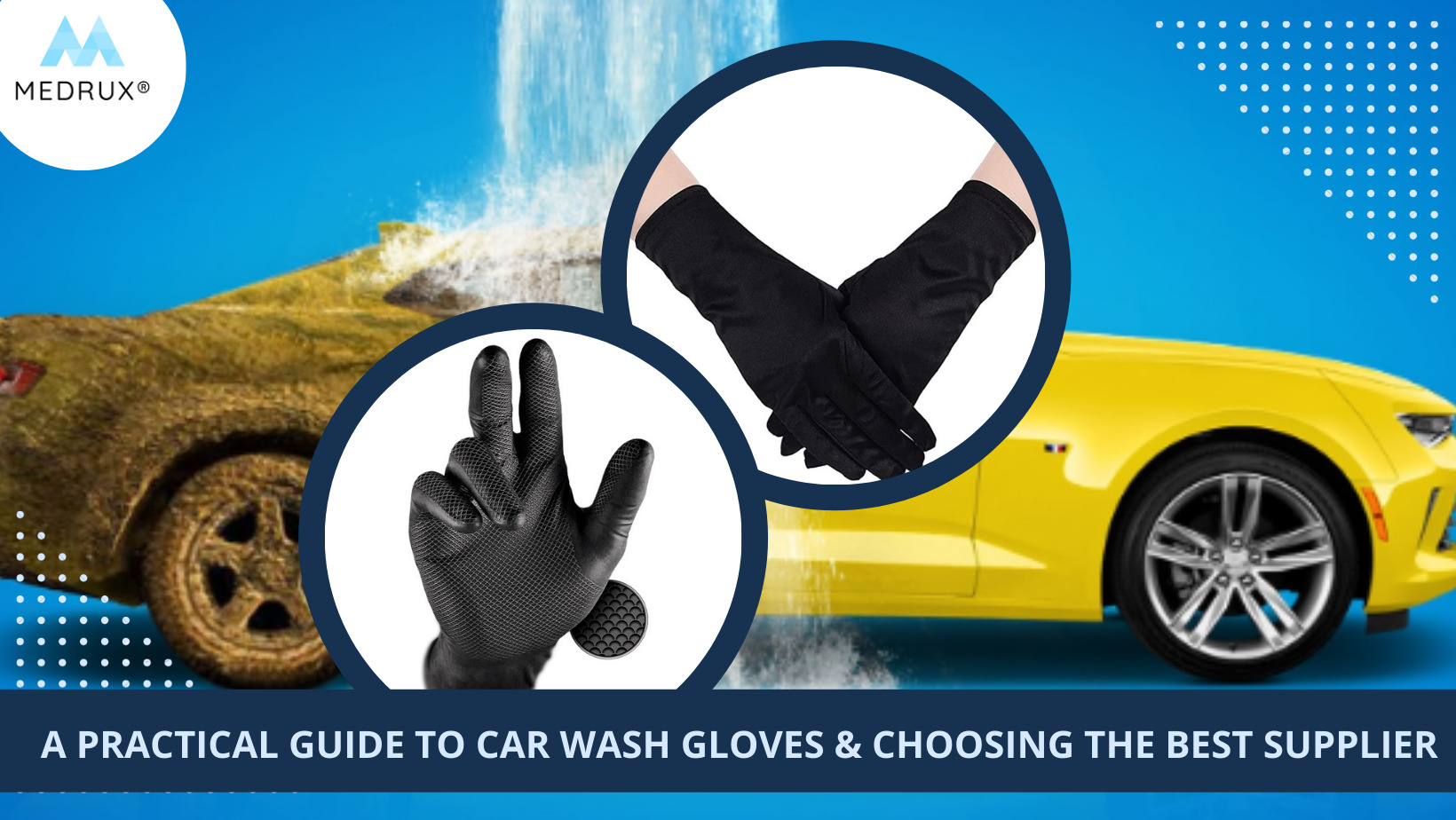You are probably here because you wish to know more about polyurethane gloves.
A long time ago, gloves were made using leather or textile.
However, as humankind advanced, the glove industry advanced as well. You will find that gloves are manufactured using different natural and synthetic materials.
This progress led to the coating of industrial gloves to improve their function. Several materials are used to coat gloves and among these options is polyurethane.
Therefore, this article will define polyurethane gloves and the materials used.
We will then take a closer look at polyurethane gloves by explaining their features and properties. Additionally, you will find all you need to know about who uses polyurethane gloves.
Then, we will inform you about the materials used to make knitted gloves. Afterward, they are going to describe the different types of coating.
Furthermore, we will examine the glove’s manufacturing process and the standards it must adhere to. Finally, we will offer tips to help you make the right glove choice.
What are polyurethane gloves?
These types of gloves are used to provide you with extra protection.
They can resist cuts, abrasions, and temperature extremes. Dipped gloves are either made from leather or knitted material.
Then, the gloves are coated with protective material to increase their efficacy. The coating can be done using nitrile, latex, or polyurethane.
Additionally, you will find that dipped gloves can either be fully or partially coated. Thus, you will have a variety of materials and options to choose from.
However, different coating materials have distinct advantages and drawbacks. So, before you make your choice, you must familiarize yourself with the different types of dipped gloves.
Therefore, tell us everything you need about polyurethane (PU) coated gloves.
What are polyurethane gloves?
Polyurethane gloves are industrial gloves fully or partially coated by polyurethane.
Industrial gloves provide workers in different fields protection against cuts, abrasions, fire, and even electricity. Thus, coating these gloves increases the level of protection they offer.
What is polyurethane?
Polyurethane is a plastic derivative. It was first industrialized during World War II in Germany. This popular material can be found around us all the time.
PU is used in furniture and house isolation. Additionally, it can be used in the medical and textile industries.
Bottomline
Polyurethane is a plastic derivative that is used to coat industrial gloves. This type of coating allows the gloves to be used in several fields.
What are the main features of polyurethane gloves?
Polyurethane coating is characterized by its lightweight.
Thus, it ensures the preservation of tactile sensitivity. You will find that there are several advantages to using polyurethane gloves. You will find that there are several advantages to using polyurethane gloves.
Advantages of PU coating
- Chemically resistant to oils, solvents, fats and greases, gasoline, and oxidation.
- Polyurethane is breathable and provides comfort.
- Low particle shedding.
- Excellent dexterity and grip.
- Suitable for dry conditions.
- Highly resistant to abrasions.
- Low cost.
Disadvantages of PU coating
- Not suitable for wet work environments.
- It can only resist temperatures up to 79 OC.
Thus, the advantages of polyurethane provide the gloves with many rewards.
Features of PU gloves
- Durable and can be used for a long duration of time.
- Available as disposable polyurethane gloves as well.
- Cut and abrasion resistant.
- Highly flexible.
- A perfect hand-like grip.
- Better dexterity than other glove coating materials.
Bottomline
The PU coating offers the gloves a thin protective outer layer.
This thin layer ensures cut and abrasion resistance. However, it maintains the flexibility and agility of the gloves. Additionally, it offers a hand-like grip.
What else do we use for coating gloves?
We previously mentioned that nitrile, latex, and polyurethane are used to coat gloves. Thus, let us take you on a tour to differentiate between the three coating materials.
-
Nitrile
Nitrile coating triples your glove’s efficacy and resistance to cuts. Nitrile provides your gloves with a more chemical-resistant external surface.
Additionally, nitrile coating can be foamed or flat. Foamed nitrile coating act as a sponge that maximizes the glove’s ability to maintain a firm grip. The foamed surface absorbs oils to reduce slipping.
However, nitrile-coated gloves have lower tactile sensitivity.
Advantages of nitrile coating
- Cut and abrasion resistant
- Chemically resistant
- Foamed nitrile gloves provide superior grip. Additionally, they are non-slippery.
- Tolerates changes in temperatures; nitrile-coated gloves are effective in temperatures that range from – 40 OC to 180 OC.
- Foamed nitrile gloves are breathable.
Thus, nitrile-coated gloves can be used if you work in the automotive industry or metal fabrication. It can also be used in oily work environments.
Bottomline
Nitrile-coated gloves can be used in several scenarios. They protect the wearer against cuts, punctures, and temperature extremes.
Additionally, foamed nitrile gloves provide a better grip as it acts as a sponge that absorbs moisture.
-
Latex
Latex-coated gloves are recommended in both wet and dry work environments. They are cut and abrasion resistant. Additionally, they are highly flexible.
Latex coating can either be foam, flat, or crinkle. Foamed and crinkled latex-coated gloves provide better protection against cuts.
However, latex-coated gloves are not a wise choice when handling organic solvents. Yet, latex coating provided a better grip than nitrile-coated gloves.
Advantages of latex coating
- Latex-coated gloves are highly flexible.
- Best dexterity.
- Provides a better grip.
- Resists cuts and abrasions, making it highly durable.
- Resists extreme temperatures.
However, latex can cause an allergic reaction in some people. Additionally, latex-coated gloves are not effective in oily work environments.
Yet, latex-coated gloves can be used in metal fabrication and wood carving. It can additionally be used on construction sites.
Bottomline
These gloves are more suitable for low temperatures. This can be attributed to their flexibility and cut resistance. They are wildly used in manufacturing glass.
However, if you are allergic to latex, avoid latex-coated gloves.
What are the different types of coating?
The type of coating affects the glove’s grip. You might be wondering now which of them provides the better grip. Well, let’s take a look at the types of coating:
Flat: This type doesn’t absorb fluids. Thus, they are only suitable for dry grip.
Foam: Foam-coated gloves provide excellent dry grip. Additionally, they have enhanced tactile sensitivity.
Crinkle: These gloves are superior in absorbing liquids. Therefore, they are outstanding in wet and dry conditions.
Sandy: Sandy coat allows the glove to be used in wet conditions.
Pattern: This coating is highly durable. Consequently, it provides a high grip performance.
When to use polyurethane gloves?
The features of polyurethane gloves make them a favorable choice. You will find that it can be used across various fields.
Let us examine some industries where you can use polyurethane gloves.
-
Electronic
Manufacturing electronics is a delicate task that requires precision and accuracy. Therefore, polyurethane gloves have the thin layer needed to maneuver small parts. Additionally, these gloves are flexible and have excellent grip.
-
Glass and metal handling
Polyurethane gloves are cut and abrasion resistant. Thus, they can withstand the sharpness of glass and metals.
Moreover, the gloves can resist a wide range of temperature differences. This allows for their use in handling hot metals.
-
Aeronautics
Like manufacturing electronics, aeronautics requires a delicate touch. The characteristics of polyurethane gloves make them a perfect candidate for the job. They are cut, abrasion, and heat-resistant. Also, they are highly flexible.
-
Construction and wood carving
Construction sites are considered hazardous locations. Therefore, workers should be completely protected. Using polyurethane gloves ensures workers’ safety against cuts and mechanical forces.
Furthermore, the cut-resistant feature of polyurethane gloves makes them a popular choice in the wood carving industry.
-
Automotives
Polyurethane gloves are oil and grease resistant. Thus, they are a perfect choice in the manufacturing of automobiles.
Additionally, they can be used by mechanics in small workshops.
Bottomline
PU gloves can be used in manufacturing electronics, airplanes, and cars. This can be attributed to the glove’s high elasticity and tactile sensitivity.
Additionally, their ability to resist cuts and abrasions makes them perfect for use on construction sites. They can also be used to carve wood and handle glass and metals.
Materials used to manufacture polyurethane-coated gloves:
Polyurethane is used to coat gloves made from different materials.
The materials used to manufacture industrial gloves are usually of high durability. Thus, when covered, these gloves withstand harsh work conditions.
Let’s take a closer look at the materials used in manufacturing industrial gloves.
-
Nylon gloves
Nylon is a thermoplastic synthetic polymer. Nylon is used in manufacturing lightweight industrial gloves.
These gloves are also more durable than cotton gloves. These gloves are also more durable than cotton gloves. Yet, they are flexible and have high tactile sensitivity. Thus, they provide better protection than disposable gloves.
Therefore, nylon gloves are used in the manufacturing of electronics.
-
Polyester gloves
Polyester gloves provide the user with adequate tactile sensitivity and dexterity. These gloves are cut and abrasion resistant. Therefore, they can be used for protection from mechanical hazards.
Additionally, polyester gloves are breathable and don’t shrink. Thus, these gloves can be used in the automotive industry and construction sites.
-
Aramid gloves
It is an artificial yarn that was first industrialized in the 1960s. Aramid gloves are of high performance as they are made by linking strong hydrogen bonds.
Aramid gloves have several features that make them superior to other gloves. These features include:
- High durability
- Abrasion resistance
- Chemical resistance
- It provides insulation and doesn’t conduct electricity
- Resist fire and high temperatures
-
Kevlar gloves
Kevlar is a lightweight artificial material derived from aramid. Thus, these gloves have some of the features of aramid gloves.
- Highly durable
- Heat resistant
- Cut and abrasion resistant
The lightweight of these gloves makes them suitable to be worn as an under glove. Additionally, they are used in handling glass and on construction sites.
-
Leather gloves
Leather provides superior heat and fire resistance. Additionally, leather gloves are cut and abrasion resistant. Therefore, they can be used by welders and in the automotive industry.
What controls the strength of the glove?
How the glove material is knit together controls several of the glove’s properties. For instance, the glove knit controls:
- Performance
- Tactility and comfort
- Cost
- Flexibility and elasticity
- Thickness and cut resistance
Bottomline
Nylon, polyester, aramid, Kevlar, and leather can all be coated with polyurethane. These materials are cut-resistant and abrasion resistant as well. Additionally, they are heat resistant.
Thus, they can be used in several options.
Fully coated vs. partially coated polyurethane gloves
After the gloves are knitted, they are either fully or partially dipped in polyurethane. The type of dipping affects the strength of the glove.
-
Fully coated gloves
These gloves provide a high level of protection. The advantages of PU coating will give the gloves higher abrasion resistance. Thus, making them perfect for construction, welding, and metal and glass handling.
-
Partially coated gloves
These gloves are only coated in the palm and finger area. Thus, they are more breathable from the back, offering more comfort. So, they are popularly used by mechanics and painters.
Bottomline
You can either choose fully or partially coated gloves for your work. This choice depends on the level of protection you wish to get.
How are polyurethane gloves coated?
After using nylon, polyester, aramid, or Kevlar to make knitted gloves, they are coated. Coating knitted gloves is a three-step process.
-
PU dipping
Polyurethane resin and dimethyl sulfoxide are used to form a solvent. Then, the gloves are dipped in the solvent for 10 or 60 seconds.
-
Water dipping
Then the gloves are dipped in a water bath. The gloves are then flushed with water for 1 to 10 minutes. This process takes place in three sinks.
The water temperature of the first glove ranges from 30 to 35 OC. The temperature of the second and third sinks should range from 50 to 55 OC.
-
Drying the gloves
The gloves are then dried by exposing them to a temperature that ranges from 100 to 110 OC. This process takes from 50 to 60 minutes.
Bottomline
The coating of knitted gloves with polyurethane in a three-step process. The gloves are dipped in the polyurethane solvent; then washed in a water bath. Finally, they are dried.
The standards used to manufacture polyurethane gloves
At this point, you might wonder about the effectiveness of these gloves. Polyurethane-coated gloves are manufactured according to two criteria, EN 420 and EN 388. These standards ensure the integrity of the gloves.
-
EN 420
This European standard defines the general requirements of industrial-coated gloves. These requirements include:
- Glove design and construction
- Resistance to water penetration
- Innocuousness
- Comfort and dexterity
- pH levels (between 3.5 and 9.5)
- Low chromium (VI) levels (< 3ppm)
According to this standard, the gloves are divided into three categories.
Category I
These gloves are used to protect against minimal risks only. A simple example of this category is leather gloves used around the house.
Category II
These gloves are used to offer protection against minimal to moderate tasks. Additionally, they should also conform to CE certification standards. These gloves are subjected to several tests. These gloves are subjected to several tests.
Furthermore, these gloves are also subjected to EN 388 standards.
Category III
Category III gloves are very complex. They are manufactured to protect against mortal threats and risks. They should also be tested by a specialized committee that ensures they follow CE certification standards.
Bottomline
The EN 420 European standard is used as a guide to manufacture industrial gloves. It provides a set of requirements for the glove’s design, sizing, pH, and resistance.
Additionally, it offers three categories for industrial gloves.
-
EN 388
This European standard provides industrial gloves’ requirements, tests, and labeling standards. The bar offers various procedures to test abrasion, tear, puncture, impact, and cut resistance.
Abrasion test
Sandpaper is used to determine the ability of the glove to withstand friction. It is used to determine the number of cycles needed to cause the glove to lose its integrity.
Tear test
The gloves are stretched using a strength testing machine. This test determines the force needed by the gloves to be torn.
Puncture test
Sharp needles are used to determine the force needed to puncture a glove.
Cut resistance test
These tests determine how many strikes will cause the glove to be torn. Two tests are used to evaluate the glove’s cut resistance; the Coup test and the TDM-100 test.
Coup test
It consists of a rotating blade that strikes a glove to determine how many will tear the gloves. However, offensive materials can cause the edge to be dull.
TDM-100 test
Measures the force needed to cut through a glove. During this test, the speed of the knife is constant, but the force applied to it is constantly changing.
Bottomline
The two European standards, EN 420 and EN 388, are used to ensure the effectiveness of industrial gloves. Manufacturers shouldn’t rely only on one of the two standards. Instead, they should use them both.
EN standards ensure cut resistance, tear and puncture resistance, comfort and design, and even pH.
Tips for choosing polyurethane gloves
Now you are ready to choose the right PU glove for your industry. However, we will offer tips to guide you through the process.
-
Assess hazards
During this step, you will ass the dangers you face during work. Thus, you can determine the areas of vulnerability in your career.
-
Select the proper glove material
Different materials provide different levels of protection. Therefore, this step is essential and depends on the hazard assessment you conclude first.
-
Familiarize yourself with manufacturing standards
This step will help you decide if the gloves you are about to purchase are practical or not. Tested gloves provide a higher level of safety.
-
Design and comfort
If you wear your gloves for an extended duration, you must choose a comfortable glove. You should also consider a flexible design and material to allow for delicate maneuvers.
-
Choose the right size gloves.
You need to determine your glove size accurately before purchasing. If your gloves are bigger or smaller than they should be, they will act as obstacles. Most manufacturers provide size charts to help their buyers.
-
The glove’s breathability
Consider purchasing breathable gloves, as this will increase your comfort. Additionally, it will ensure your adherence to wearing them at all times.
Final thoughts
Coated gloves are knitted gloves dipped in nitrile, latex, or polyurethane. These knitted gloves are made from nylon, polyester, aramid, and Kevlar. All these materials are cut, abrasion, and heat resistant.
However, coating them ensures that their ability to resist mechanical hazards is doubled. Therefore, they are the most preferred choice for industrial purposes.
Thus, polyurethane gloves need to follow European standards to ensure their effectiveness.
Throughout this article, we have offered you all the information needed to purchase polyurethane gloves.
Now we believe you are ready to go ahead and make your choice.








